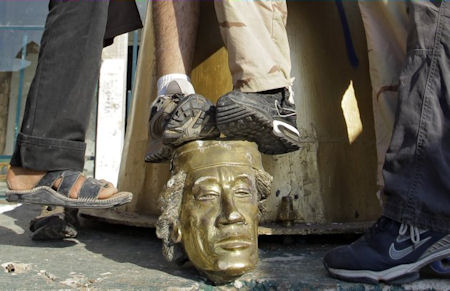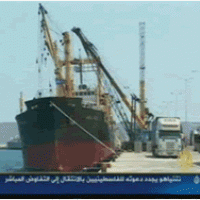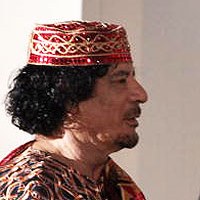![]()
Tue, Aug 23, 2011 | Debka.com

Rebel fighters trample on a head of Muammar Gadhafi inside the main compound in Bab al-Aziziya in Tripoli, LIbya, Tuesday, Aug. 23, 2011. (AP Photo/Sergey Ponomarev)
Gaddafi flees Tripoli with family. What’s next: Guerrilla or tribal warfare?
Muammar Qaddafi, his sons and military and political elite are reported by debkafile’s military sources to have abandoned their Bab al Aziziya fortress early Tuesday, Aug. 23, using his son Saif al-Islam’s surreal appearance before foreign reporters earlier in the day to cover their escape.
Our sources believe they exited the compound through one of the underground tunnels of the compound’s military complex. But regional intelligence experts are baffled by the enigma of the mysterious sudden disappearance of Qaddafi’s divisions overnight. It’s as though the ground swallowed them up leaving no trace.
No one knows Qaddafi’s destination but informed observers expect him to make for Sebha in southern Libya where the local tribes are loyal to whom and where he established a whole range of subterranean military facilities. And that is where he located Libyan nuclear facilities in 2000, which he later agreed to dismantle. Qaddafi may have equipped a place of asylum at Sebha with military and residential facilities form which to launch a guerilla war against whomsoever takes power in Tripoli and against NATO targets in Libya and Europe, as punishment for his downfall.
Thousands of fighters from the tribes loyal to Qaddafi are reported by debkafile’s military sources to have been streaming to the desert town in recent weeks. Prominent among them were members of his own Gaddadfa tribe which numbers some 100,000 members and is based in Sirte, a town lying on the Mediterranean coast in the north between Tripoli and the rebel base of Benghazi. Qaddafi will need the help of tribes other than his own in a region 800 kilometers south of his home town on the fringes of the Sahara, for waging a guerrilla war against the new rulers in Tripoli.
Debkafile reported earlier Tuesday:
Debkafile’s military sources report that British, French, Jordanian and Qatari Special Operations forces Tuesday, Aug. 23, spearheaded the rebel “killer strike” on Muammar Qaddafi’s regime and Tripoli fortress at Bab al-Azaziya, Tripoli. This was the first time Western and Arab ground troops had fought together on the same battlefield in any of the Arab revolts of the last nine months and the first time Arab soldiers took part in a NATO operation.
Our military sources report that the British deployed SAS commandoes and France, 2REP (Groupe des commando parachutiste), which is similar to the US Navy DELTA unit, as well as DINOP commandos. Fighting too were Jordan’s Royal Special Forces, specialists in urban combat and capturing fortified installations like the Qaddafi compound in Tripoli, and the Qatari Special Forces, which were transferred from Benghazi where they guarded rebel Transitional National Council leaders.
According to our military experts, even after getting through into the compound, this combined force faced four obstacles to before reaching its military heart which is largely underground:
1. Because it is too small to carry the two tasks of breaking into the heart of the Bab al-Azaziya complex which covers some 6 square kilometers and at the same time overwhelm Qaddafi’s 12th Tank Division also underground, this force needed to be backed by larger trained contingents armed with anti-tank weapons, which would advance into the labyrinth under close air cover from assault helicopters.
Britain and France transferred Apaches to Libya two months ago but never used them in Tripoli where they would be vulnerable to Qaddafi’s anti-air missiles.
2. The main body of the rebels to the rear of the combined foreign force was nowhere near being a unified military force.
The rebels who took part in the first major push into Tripoli Sunday, Aug. 21, turned out to be mostly Berber tribal fighters from the Nafusa Mountains in the West, divided into small groups of no more than 100, each representing a different village. They have never trained together or acquired experience in urban warfare. NATO imported better-trained fighters by sea from Benghazi and Misrata.
3. The great black clouds seen over the compound and caused by NATO jet bombardments and anti-tank fire may look menacing but they are not evidence of heavy fighting in or around the compound. And indeed it was soon over. As the rebel forces burst in, there was no sign of Qaddafi himself or his family and commanders. They were presumed to have fled.
4. NATO was short of specific intelligence about the military nucleus of Bab al-Aziziya. Most of its key facilities are underground and proof against bombardment.
Western alliance warplanes pummelled the compound month after month from March 19. They flattened the surface residential buildings and command centers, but their ordnance never reached the buried facilities. Our military sources say these chambers are interconnected by a network of corridors, some broad enough to accommodate tanks. The network branches out to the sea and locations outside Tripoli.
Sunday, Aug. 21, debkafile’s military sources reported that the Qaddafi regime has fallen in Tripoli, but there is quite a way to go before the war is over.



 RSS
RSS










#Gaddafi flees #Tripoli with family. What’s next: Guerrilla or tribal warfare? | #Libya http://t.co/RlKJTQJ
Gaddafi flees Tripoli with family. What’s next: Guerrilla or tribal warfare? | Middle East news, art http://t.co/6MHbEUE
Gaddafi flees Tripoli with family. What’s next: Guerrilla or tribal warfare? | Middle East news, art http://t.co/6MHbEUE
#Gaddafi flees #Tripoli with family. What’s next: Guerrilla or tribal warfare? | #Libya http://t.co/RlKJTQJ